|
Abe Anjin
Bizen's Romantic Neoclassicism
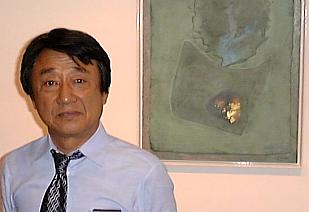
Abe Anjin (2001)
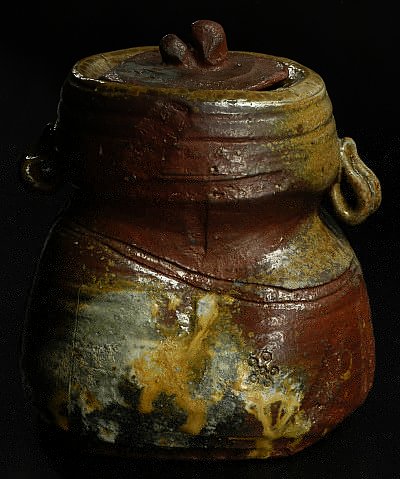
White Goma Mizusashi by Abe Anjin
In front of my eyes, a man in his late sixties placed two precious Momoyama-period Shino plates in his hands, and began to violently crack them together in rhythmical epiphany, as if they were brass cymbals.
Startled, my eyes settled on the scene in disbelief.
"You see," said Abe Anjin to me with a grin, "this is the difference between the Shino of antiquity and the Shino of today. Back then, Shino was rock hard. This will hardly chip it."
He proceeded to rapidly grind the bases together, like how one would smooth a surface with sandpaper. Having done his deed, Abe passed the plates to me, and I observed the bases for fresh scars. Not only were they unscathed, but they were unlike any Shino I've had the privilege of holding.
"So you're saying that the feldspar used today is not the Shino of Momoyama?"
"Essentially. They used to high-fire Shino to the bone. And the base glaze ingredient was silica, not feldspar."
"Did Arakawa Toyozo err when he created his interpretation of Momoyama Shino in the 1950s?"
"Mistaken, perhaps. Or simply content with capturing the appearance of Momoyama, rather than actually reviving the elements behind Momoyama. If it looked like Momoyama, and if it could pass as Momoyama, then to Toyozo, it was good enough. That was Toyozo's own version, for sure. The problem arises when we begin to confuse the latter for the former. The same goes for Kaneshige Toyo's works."
This is Bizen's Abe Anjin, speaking to me with passionate fervor on the subject of Shino ware. The cheeky smirk does not dissipate, even though he hangs a smoky cigarette from his lips.
To Anjin, Bizen was a later love. Before embracing pottery, he made a name for himself as a painter, having been comrades in arms with the famous Ikeda Masuo (the first Japanese national to have a solo exhibition at MOMA New York).
Today, Anjin is a Bizen potter of the first order, as well as a scientist and historian. Others call him a conspiracy theorist, or a man out to ruin Bizen and its treasured history. Conservative circles have persevered to undermine his works as "Momoyama copies" or "fake Bizen."
His Bizen, in other words, sparks controversy.
They miss the point.
"You have to admit what is good as good," said art critic Shirasu Masako, when writing an eulogy for Kato Tokuro, who was castigated for his hand in the Einin Tsubo Incident.
I second the thought, as Anjin's work is beyond extraordinary.
I have three Bizen contemporary favorites. One is Kakurezaki Ryuichi, of zig-zagged sculptural fame. Kakurezaki proposed a new individualism for Bizen, which was overly reliant on the forms of the Momoyama golden era. Not only did he boldy challenge these forms, he made ingenious new shapes and cuts that rippled with a creativity not seen in traditional/functional wares since the death of legendary Kamoda Shoji.
Another potter is Mori Togaku, the living embodiment of the phrase "bigger is better." It is Togaku who ambitiously revived the o-gama, or the gigantic communal kilns of the Momoyama period. The feat itself will place Togaku's name in Japanese ceramic history. But one must not miss what he had produced from those kilns. His works, often with pale tsuchiaji (clayflavor) and a delicate patchwork of goma (sesame ash), contains a silent, noble confidence that is nearly spiritual.
And then, we have Abe Anjin. I find in his works a perfect balance between form, firing, and deepness of spirit.
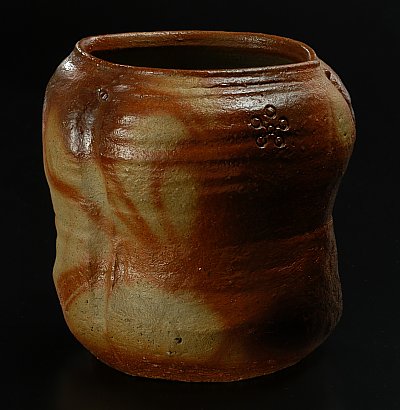
Hidasuki Mizusashi by Abe Anjin
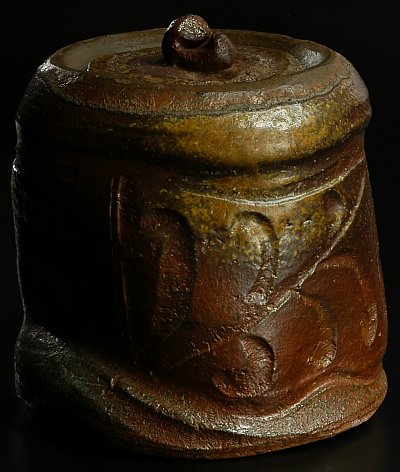
Shinogi Mizusashi by Abe Anjin
His tsuchiaji is satisfyingly distinctive, with a dark, wet luminance that is both seductive and soothing. His golden goma carries a tinge of mossy green, and is so rich with energy that you can almost feel the intensity of the flames that had melted the ash upon the Bizen surface. His forms are dreamy materializations of Momoyama elegance enthused with modern chic, holding such finely tuned balance between size and shape that a tokkuri (sake flask) or guinomi (sake cup) just simply melts into one's palms. His Bizen is instantly recognizable as his, and evokes the romantic grandeur of Momoyama's finest; in other words, Anjin's Neoclassicism is the fusion of his own artistic sensibilities and the sensibilities of the late 16th century's unknown craftsmen.
But I would like to further emphasize the fact that Anjin's works are more revolutionary than how they might appear on the surface.
You see, Anjin's works are so utterly and inherently his, for they are made and fired in a way unlike all others. Allow me to explain.
Bizen, before the arrival of Kaneshige Toyo, had lost much of its ancient appeal. It was a dilapidated kiln site, and much of the wares that came from it before World War II were ornamental or sculptural wares that were worlds apart from the Bizen of old. Clay flavor was lost, as well as the traditional techniques of clay processing and firing.
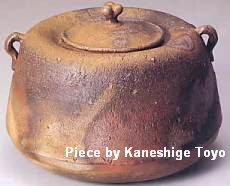 Enter Kaneshige Toyo. Enter Kaneshige Toyo.
Toyo wanted to recapture the allure of Momoyama Bizen, yet had no precedent or teacher to follow. In other words, he had to start from ground zero. Young Toyo eventually discovered that a form of Bizen clay, called Tatsuchi (paddy clay), could be easily fired with a revamped noborigama (rising kiln) to produce kiln effects that closely resembled medieval Bizen. Firing temperatures were a relatively low 1150 to 1180 degrees celcius, and with the introduction of charcoal, kiln effects could be readily simulated.
The techniques of Toyo soon spread throughout Bizen, with the Isezaki, Fujiwara, and Yamamoto families all jumping aboard the Toyo wagon. Toyo was thus revolutionary, in that he founded a method for which old Bizen could be reproduced by all. Of course, the noborigama isn't the only method available today; take for example Isezaki Jun's anagama (underground kiln), or Mori Togaku's o-gama (as explained above). Various types of kilns exist, but it is not exaggeration to say that the Toyo-type noborigama is the kiln of choice for nearly 70% of contemporary Bizen potters.
And furthermore, a common element that links modern and contemporary Bizen potters, regardless of kiln type, is that most perceive Bizen clay to be synonymous with Tatsuchi, and Tatsuchi alone. Tatsuchi had become a precious, expensive commodity.
In other words, the Bizen of today was both single-handedly created and dictated by the methods of Kaneshige Toyo. And it was the techniques of Toyo which were deemed an "important intangible cultural property" that were to be passed down and preserved for following generations.
The Toyo method, hence, slowly seeped into common consciousness as a "traditional" method passed on from the days of old, and the fact that the Toyo method was a 20th century invention soon became forgotten. The paradigm shift had been completed. To question the validity or the superiority of Toyo's contributions was unthinkable.
Enter Abe Anjin.
Anjin is revolutionary in that he openly rejected the historical skewing of the Toyo method as analogous to that of Momoyama Bizen. Through a completely innovative firing technique and the use of Yamatsuchi (mountain clay), Anjin's protests have materialized in his works.
"The deep beauty of the great Momoyama-period Bizen works can't be recreated without using the materials and techniques of Momoyama."
"And what techniques and clay were used?"
"You see, the very few works that are considered 'meihin' or 'great works' of Momoyama Bizen are essentially tea wares. Mizusashi, chawan, chaire, for example. These wares are not utilitarian wares, and no such shards of that stature have been excavated in the three remains of the ancient o-gama. In other words, the o-gama were never meant to produce works for the Tea Ceremony of the samurai, as these pieces were considered aristocratic fine art, made for a small and elite audience. On the other hand, the o-gama were used specifically for making peasant utilitarian wares, such as jars, bowls, and dishes. Thus in essence, two very different types of Bizen wares were produced during the Momoyama, and for very different purposes. Yet, history has confused and assimilated the two kinds of wares (tea ware, peasant ware) as being born from the same kiln, and as being made by the same craftsmen. This is the error. The tea wares were probably made by expert craftsman specifically commissioned by Sen Rikyu and other Tea Masters. Since the number of commissioned wares were few, an o-gama would be inherently impractical. Rather, a small kiln was needed. And furthermore, if one observes the Momoyama masterpieces, one can tell that the kiln effects evidence the fact that each piece had been meticulously fired no less than three times per piece. If one observes the actual clay under an advanced microsope, the chemical and molecular difference between Momoyama classics and the utilitarian o-gama wares is again evidenced. Each masterpiece was fired to the core at extreme temperatures. But Bizen Tatsuchi clay, with its low heat resistance, can only withstand a single firing, or a firing that does not go above 1180 degrees. Therefore, Tatsuchi could not plausibly be the material used for Momoyama Bizen teaware."
Anjin just threw the self-proclaimed history of Bizen out the window.

Goma Mizusashi by Abe Anjin
"I get it. So what you're saying is that not only was the o-gama impractical when firing specially commissioned tea wares for tea masters, but the clay used could not have been Tatsuchi, as it was too weak a clay to withstand the fires needed to create a Momoyama Bizen masterpiece."
"Correct. In other words, they used a small underground anagama, which could be easily, quickly, and intensely fired in a small space, and which could reach temperatures above 1300 degrees. And the Bizen clay that was needed to withstand such temperatures could only have been Yamatsuchi."
"Yamatsuchi and anagama. Just like how you make your works."
"Right. I think my works are essentially different from other Bizen potters. The materials and the firing methods are completely different. They are, in essence, two very different kinds of Bizen. The Toyo method does not fire to the core. It merely cooks the surfaces. It merely cooks the glazes. My technique scorches the depths of the clay."
Anjin has paved the way for a completely new method, the Anjin Method, of firing Bizen. Of course, Anjin does not claim those methods to be "new." But I think it is important to recognize Anjin's Neoclassicism as a viable and vibrant alternative to the status quo of Toyo's style. And furthermore, Anjin's method contains a great ethical and practical virtue: it conserves the use of wood by up to 30%.
"I cringe when I hear other potters openly boasting about how much red pine they've used to fire their kilns. What's to boast about, as they're just destroying entire forests! With my method, any kind of wood can produce the same effects as seen in my works. It's that simple. You can use old wood, old furniture, old bats, whatever. The end product will be the same."
With the propagation of more and more Anjin kilns, not only will we see a greater variety of Bizen styles than the dearth of empty and uninteresting Bizen we see today, but we will also help save the environment. And who could argue with that?
Many.
Anjin has had an uphill struggle to be recognized, as his theories and his style were directly antagonistic to the entrenched history and tradition of Momoyama Bizen and Toyo's Bizen.
"I, in no way, intended to criticize Toyo's methods or contributions to modern Bizen. I just wanted to offer an alternative. And in regards to refuting the history of the o-gama or the clay used, my theories are strictly academic, and ironically, are separate from my pottery. I don't see why the people of Bizen should criticize my scientific research. If they think otherwise, I ask that they disprove my science in a fair manner. I have the data, and I think it is perfectly reasonable for them to do their own research in order to evidence their traditional assertions. Unfortunately, not a single person has approached me with such evidence. All they throw at me are words."
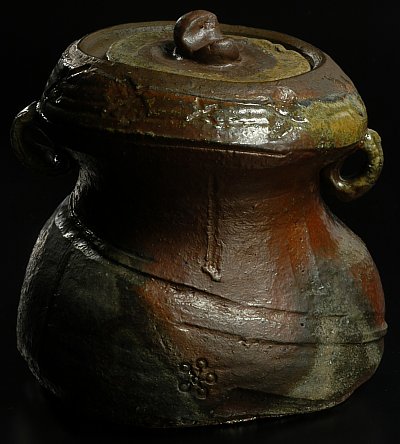
Wari Mizusashi by Abe Anjin
When an outsider comes along with ideas that turn long-held conventions upon their heads, many people, afraid and uncertain, instinctively move to persecute the preacher. It is an act of self-defence. Galileo, Darwin, Freud. Science seems to scare people. And so it is with Anjin's contributions.
Anjin is slowly building a small clan of apprentices who fire and use the same clay as Anjin. Their works, in regards to clay flavor and kiln effects, look identical to Anjin's works. This is not surprising, as they loyally follow every precise firing procedure as laid out by Anjin.
Such potters as Morimoto Naoyuki and Sueta Megumi are making names for themselves with amazing work, although they still haven't reached the balanced sleekness of their teacher's forms.
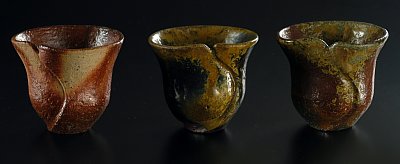
Three Guinomi by Sueta Megumi
(click image for larger photo)
But it is wholly satisfying to see that the Anjin method and the Toyo method can co-exist. I believe the possibilities of Bizen are infinite. Bizen clay is extremely versatile, and there exists a great variety of Bizen clay besides Tatsuchi or Yamatsuchi. In actuality, there are at least eight kinds of Bizen clay, all with different characteristics and firing temperatures. Bizen's potential has hardly been tapped, and I will not want to see its beauty grow complacent through a blind adherence to myths or tradition.
Bizen must move forward, and Anjin is but one answer.
One should not underestimate Anjin's contribution to Bizen, nor doubt his passion for Bizen. He thinks, just like I do, that what matters in the end is the work itself. If it is beautiful, any method will do. And if the final destination is indeed beauty, Anjin is paving another beautiful path for us to take.
End story on Abe Anjin
Interview & story by Aoyama Wahei
written for yakimono.net & e-yakimono.net
INDEX TO
ALL STORIES
by Aoyama Wahei
|